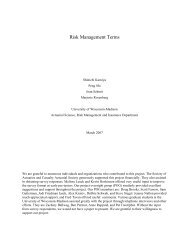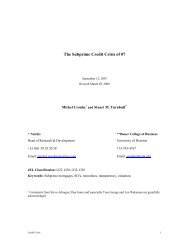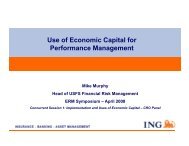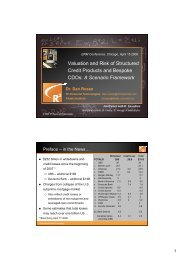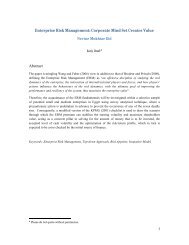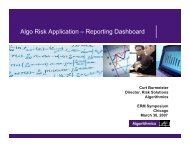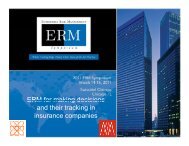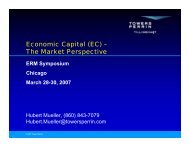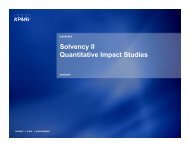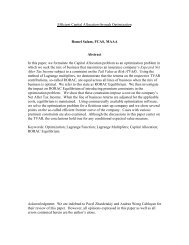Bayesian Risk Aggregation: Correlation ... - ERM Symposium
Bayesian Risk Aggregation: Correlation ... - ERM Symposium
Bayesian Risk Aggregation: Correlation ... - ERM Symposium
You also want an ePaper? Increase the reach of your titles
YUMPU automatically turns print PDFs into web optimized ePapers that Google loves.
of inter-risk correlations a tricky exercise.<br />
There are several reasons for these difficulties. First, there is the question regarding<br />
internal versus external data. The general opinion is that risk proxies should be derived<br />
from bank-internal data because it is more related to the companies’s specific business<br />
strategy. However, internal time series may be hard to come by or difficult to re-build<br />
after a merger or a company’s re-organisation, resulting in quite short risk-proxy time<br />
series reducing the statistical significance of correlation estimates. A consequence thereof<br />
is that bank-internal proxies are often amended by external data, at least for some risk<br />
types. Another problem is to find a common frequency that provides a natural scale for<br />
all risk types. Usually, risk proxies for different risk types are measured at unequal time<br />
intervals and therefore further assumptions and approximations have to be used to make<br />
risk proxies comparable. For example, market risk data are available at a daily basis<br />
whereas proxies for business risk are often based on accounting information and therefore<br />
exist only at quarterly or even yearly level, creating a bottleneck for statistical correlation<br />
estimation.<br />
These drawbacks of a purely statistical analysis based on risk proxies show that it is<br />
often necessary to include a new dimension, namely expert judgement. The usage of some<br />
kind of judgemental approaches when assessing inter-risk correlations is very popular in<br />
the banking industry, however, most of the employed approaches lack a sound scientific<br />
basis. For instance, the widely used method of “ex-post adjustments” of the statistical<br />
correlation estimates cannot be properly formalised, thereby nourishing fears and doubts<br />
concerning the final figures.<br />
In contrast to this, a <strong>Bayesian</strong> approach for risk aggregation such as we are proposing<br />
here allows to treat empirical data on the one hand and expert knowledge on the other as<br />
two distinct sources of information that are eventually amalgamated by means of Bayes<br />
theorem. In this way it is possible to exploit at the maximum extent both information<br />
sets without contamination effects (i.e. experts that are biased (“anchored”) by the data<br />
and, vice versa, data that is manipulated by the expert).<br />
The <strong>Bayesian</strong> choice for risk aggregation means that the experts’ beliefs about the as-<br />
sociation between different risk types have to be encoded in the pairwise correlation priors<br />
πi(·) for i = 1, . . . , 6, introduced in Section 3.1. This process is referred to as elicitation<br />
of the prior distributions. Elicitation is a difficult task and a number of different compe-<br />
tencies are required to perform it correctly, not only from a statistical point of view but<br />
also on the psychological side. A readable textbook on this intriguing subject is O’Hagan<br />
et al. [19]. Without going into detail, we want to mention that people are typically em-<br />
ploying only a few strategies or heuristics to quantify uncertainty or to make decisions<br />
under uncertainty, see e.g. Tversky & Kahneman [25]. Consequently, the way questions<br />
17



